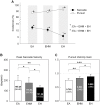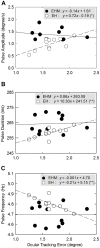Eye-hand synergy and intermittent behaviors during target-directed tracking with visual and non-visual information
- PMID: 23236498
- PMCID: PMC3517518
- DOI: 10.1371/journal.pone.0051417
Eye-hand synergy and intermittent behaviors during target-directed tracking with visual and non-visual information
Abstract
Visual feedback and non-visual information play different roles in tracking of an external target. This study explored the respective roles of the visual and non-visual information in eleven healthy volunteers who coupled the manual cursor to a rhythmically moving target of 0.5 Hz under three sensorimotor conditions: eye-alone tracking (EA), eye-hand tracking with visual feedback of manual outputs (EH tracking), and the same tracking without such feedback (EHM tracking). Tracking error, kinematic variables, and movement intermittency (saccade and speed pulse) were contrasted among tracking conditions. The results showed that EHM tracking exhibited larger pursuit gain, less tracking error, and less movement intermittency for the ocular plant than EA tracking. With the vision of manual cursor, EH tracking achieved superior tracking congruency of the ocular and manual effectors with smaller movement intermittency than EHM tracking, except that the rate precision of manual action was similar for both types of tracking. The present study demonstrated that visibility of manual consequences altered mutual relationships between movement intermittency and tracking error. The speed pulse metrics of manual output were linked to ocular tracking error, and saccade events were time-locked to the positional error of manual tracking during EH tracking. In conclusion, peripheral non-visual information is critical to smooth pursuit characteristics and rate control of rhythmic manual tracking. Visual information adds to eye-hand synchrony, underlying improved amplitude control and elaborate error interpretation during oculo-manual tracking.
Conflict of interest statement
Figures








References
-
- Crawford JD, Medendorp WP, Marotta JJ (2004) Spatial transformations for eye-hand coordination. J Neurophysiol 92: 10–19. - PubMed
-
- Hocherman S, Levy H (2000) The role of feedback in manual tracking of visual targets. Percept Mot Skills 90: 1235–1248. - PubMed
-
- Gritsenko V, Yakovenko S, Kalaska JF (2009) Integration of predictive feedforward and sensory feedback signals for online control of visually guided movement. J Neurophysiol 102: 914–930. - PubMed
-
- Vercher JL, Sarès F, Blouin J, Bourdin C, Gauthier G (2003) Role of sensory information in updating internal models of the effector during arm tracking. Prog Brain Res 142: 203–222. - PubMed
-
- Mather JA, Lackner JR (1981) The influence of efferent, proprioceptive, and timing factors on the accuracy of eye-hand tracking. Exp Brain Res 43: 406–412. - PubMed
Publication types
MeSH terms
LinkOut - more resources
Full Text Sources

